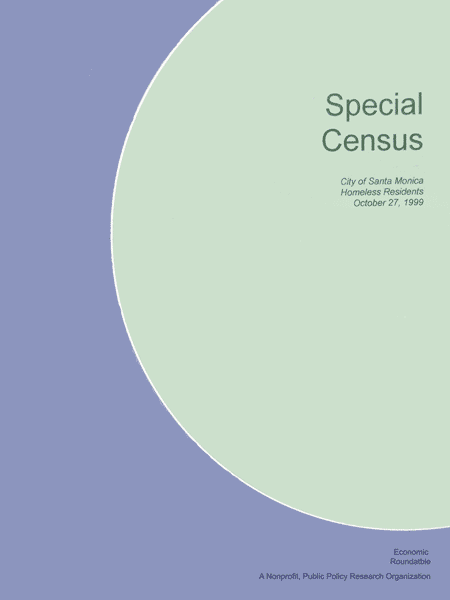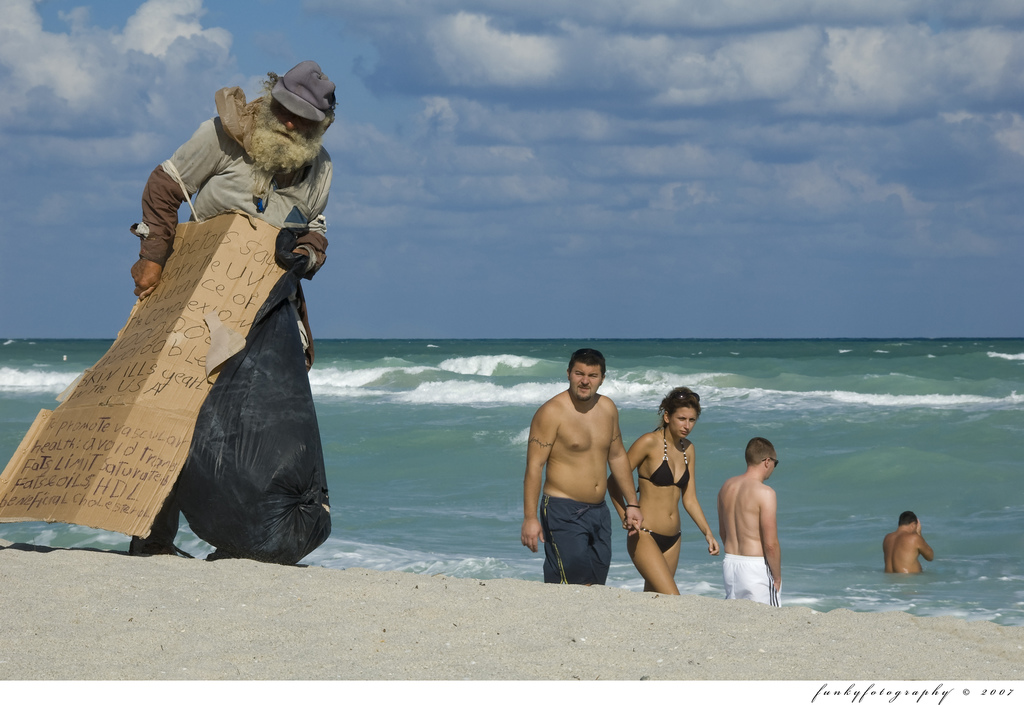 A special census of Santa Monica’s homeless population was carried out on Wednesday, October 27, 1999. Homeless residents were defined as individuals who did not have a regular place of their own where they could sleep. The Economic Roundtable, a nonprofit research organization, planned and coordinated the count under a contract from the City of Santa Monica. Fifty-eight individuals from 15 organizations carried out the actual enumeration. Census takers were grouped in teams of three. Each team was led by an outreach worker from a homeless service agency and
A special census of Santa Monica’s homeless population was carried out on Wednesday, October 27, 1999. Homeless residents were defined as individuals who did not have a regular place of their own where they could sleep. The Economic Roundtable, a nonprofit research organization, planned and coordinated the count under a contract from the City of Santa Monica. Fifty-eight individuals from 15 organizations carried out the actual enumeration. Census takers were grouped in teams of three. Each team was led by an outreach worker from a homeless service agency and
also included a student volunteer and a homeless person.
The central problem in counting homeless residents is that they are “placeless,” making them difficult to find and count, and raising the possibility that if they are counted at all they may be counted more than once. Conducting a person-based rather than housing-based census posed at least two problems for producing a reliable estimate of Santa
Monica’s homeless population:
- Because homeless residents were counted at several times of day and in multiple locations in order to achieve the most complete count possible, some individuals were counted more than once, making it necessary to eliminate duplication.
- Some homeless individuals were missed during the count, so it was necessary to estimate the number of uncounted persons in order to estimate the size of the total homeless population.
Estimated Population of Homeless Residents
The special census raw count was reduced to eliminate internal duplication, and then increased to offset uncounted individuals. This methodology produced the following estimated total number of homeless residents in Santa Monica:
- Total number of homeless persons in shelters and indoor locations: 396
- Less persons in rehabilitation programs who were not previously homeless: -21
- Total number of homeless persons counted in outdoor locations: +557
- Less corrections for duplicate counts and nonresidents: -87
- Less half of persons whose homeless status was uncertain: -13
- Plus estimated number of persons uncounted in outdoor locations: +205
- ESTIMATED TOTAL HOMELESS POPULATION: 1,037
The homeless population was bracketed by low-range and high-range estimates of from 950 to 1,084.
Population Profile
Information from 482 individual survey questionnaires that were completed as part of the census was used to create a profile of Santa Monica’s homeless residents
- Slightly over one-quarter of homeless residents were women and three-quarters men. Women made up a disproportionately large share of the shelter population and men predominated among residents sleeping outdoors.
- The average age of homeless residents was 41 years.
- Individuals sleeping in shelters tended to be younger than those sleeping outdoors.
- Ethnic and racial characteristics of homeless residents were similar inside and outside of shelters. Half were White, one-quarter African American, 18 percent Hispanic, 3 percent American Indian, and 2 percent Asian.
- On the night of the Census one-third (36 percent) of homeless residents slept in shelters and two-thirds (64 percent) slept outdoors.
- Among homeless residents, 80 percent said they were homeless regularly.
- The lowest rates of chronic homelessness were among young adults in their mid-twenties to mid-thirties, with the next lowest group 55 or older.
Use and Availability of Services
Homeless individuals were asked what services they had used in the past year and what services they needed but were unable to obtain. Choices included food, shelter, clothing, medical or dental, public assistance, counseling, rehabilitation, job training, and other (with an opportunity to describe “other”).
- Nearly three-quarters of homeless residents reported using food services, and half shelter, clothing and health services. These were followed, in order of frequency, by public assistance, counseling, rehabilitation, and job training.
- Women appeared to be more successful, or motivated, than men in gaining access to every service except food, rehabilitation, and job
- Older residents reported the lowest rate of service use.
- Shelter was identified by 38 percent of unsheltered residents as having been needed but unavailable.
- Unsheltered residents reported greater difficulty obtaining services than sheltered residents did.
- Individuals in the 18-to-24 age group reported having been unable to obtain needed services at a rate that was roughly double that of other age groups.
- Hispanics reported above-average rates of unmet needs in the areas of food, clothing and rehabilitation.
- Hispanics were twice as likely as members of other ethnic groups to say that they had been unable to gain access to rehabilitation (drug treatment) services.
- Sixteen percent of homeless residents reported difficulty in getting help finding a job.
A complete copy of the report can be downloaded here
Chapter Headings:
- Executive Summary
- Counting Homeless Residents of Santa Monica
- Count of Homeless Residents
- Population Profile
- Use and Availability of Services
- Appendix
- Bibliography

Photograph by © Robin Ervolina, funkyfotography, “Can You Hear Me Now?” with permission granted to Economic Roundtable on april 19, 2024. Please follow the link for terms of use in order to avoid violation of copyright: https://flickr.com/people/funkybug/ Protected under the CC BY-NC-ND 2.0 DEED license.












